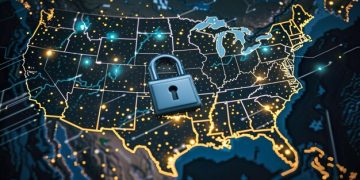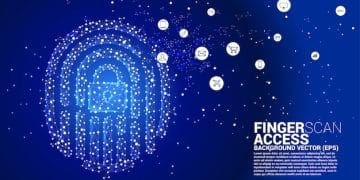Safeguarding Your Finances: A Comprehensive Guide Against Identity Theft

Identity theft and financial fraud pose significant threats to personal financial security, requiring proactive understanding and the adoption of robust protective measures to safeguard assets and personal information in an increasingly digital world.
In an era defined by digital transactions and interconnected systems, the landscape of personal finance has been irrevocably altered. While convenience abounds, so too do the risks, perhaps none as insidious and financially devastating as identity theft and fraud. Understanding Personal Finance: How to Protect Your Finances from Identity Theft and Fraud is no longer just advisable; it’s an indispensable component of sound financial management for every individual navigating the complexities of modern economic life.
understanding the evolving landscape of identity theft and fraud
The nature of financial crime is constantly evolving, moving beyond traditional methods to embrace sophisticated digital exploits. Identity theft and financial fraud are no longer solely about stolen wallets; they encompass a vast array of schemes designed to compromise your personal and financial information. This section delves into the modern face of these threats, highlighting the ingenuity of fraudsters and the subtle, often unseen, ways they attempt to exploit individuals.
Modern identity theft often begins with seemingly innocuous data breaches from large corporations or phishing attempts that mimic legitimate entities. These tactics are designed to trick you into divulging sensitive information, such as passwords, bank account numbers, or Social Security details. Once obtained, this information becomes a powerful key for fraudsters to unlock your financial world, from opening new credit lines in your name to draining existing accounts.
common types of financial fraud and identity theft
Fraudsters employ a diverse arsenal of techniques. Understanding these common types is the first step in building a robust defense:
- Phishing and Smishing: These involve deceptive emails (phishing) or text messages (smishing) that appear to be from reputable sources, prompting you to click malicious links or provide personal data.
- Account Takeover Fraud: Criminals gain unauthorized access to your existing financial accounts, such as bank accounts, credit card accounts, or investment portfolios, and then proceed to make unauthorized transactions.
- New Account Fraud: Identity thieves use your stolen personal information to open new financial accounts in your name, accumulating debt that eventually falls back on you.
- Synthetic Identity Fraud: This sophisticated crime involves combining real and fake personal information to create a new, fabricated identity, often using a real Social Security number with a fictitious name and date of birth.
The pervasive nature of financial fraud means that continuous vigilance is required. The digital footprint we leave online, coupled with the increasing complexity of financial transactions, offers numerous potential vulnerabilities. Being informed about current fraud trends, such as cryptocurrency scams or tech support scams, empowers individuals to recognize and avoid these pitfalls effectively.
In essence, grasping the breadth and depth of modern identity theft and fraud is paramount. It’s not just about protecting your assets but also safeguarding your credit history and overall financial well-being from malicious actors who are constantly refining their methods. This foundational understanding sets the stage for implementing practical, actionable protective measures.
proactive measures: fortifying your digital and physical defenses
Protecting your finances from identity theft and fraud requires a multi-pronged approach that addresses both digital and physical vulnerabilities. Merely reacting to incidents is insufficient; a proactive strategy is essential. This section outlines concrete steps individuals can take to build strong defenses, making it significantly harder for criminals to compromise their financial security.
The first line of defense often lies in common-sense practices that, while seemingly minor, collectively create a formidable barrier. This includes everything from how you manage your online passwords to how you dispose of sensitive documents. Every detail matters when it comes to safeguarding your personal financial information from potential threats.
strengthening digital security habits
In our digital age, robust cybersecurity practices are non-negotiable for financial protection:
- Strong, Unique Passwords: Use complex passwords for all online accounts, especially financial ones. Combine uppercase and lowercase letters, numbers, and symbols. Avoid using easily guessable information like birthdays or pet names.
- Multi-Factor Authentication (MFA): Enable MFA wherever possible. This adds an extra layer of security, typically requiring a code sent to your phone or a biometric scan in addition to your password.
- Be Wary of Phishing: Always scrutinize suspicious emails or messages. Never click on links or download attachments from unknown sources. Verify the sender’s identity independently if unsure.
- Secure Wi-Fi Networks: Avoid conducting financial transactions on public, unsecure Wi-Fi networks. If you must, use a Virtual Private Network (VPN) to encrypt your data.
Beyond digital practices, physical security of information is equally vital. Simple habits like shredding documents containing personal data can prevent dumpster diving fraud. Regularly checking your physical mailbox for suspicious correspondence or missing statements can also alert you to potential issues. The fusion of strong digital and physical security habits forms the bedrock of effective financial protection.
Implementing these proactive measures may seem time-consuming initially, but the peace of mind and protection they offer far outweigh the effort. They move beyond mere recommendations to become essential components of a secure financial lifestyle, diminishing the likelihood of becoming a victim of intricate fraud schemes.
monitoring and vigilance: essential tools for early detection
Even with the most robust proactive measures, the threat of identity theft and fraud can never be entirely eliminated. Therefore, constant monitoring and vigilance are crucial for early detection, allowing you to react swiftly and mitigate potential damage. This section spotlights essential tools and practices that empower individuals to keep a close watch on their financial footprint and personal information.
The ability to spot irregularities quickly is often the difference between a minor inconvenience and a major financial crisis. From credit reports to bank statements, every piece of financial documentation holds clues that can indicate unauthorized activity. Developing a routine for reviewing these items is a cornerstone of financial security.
key monitoring techniques and resources
Leveraging available resources for financial oversight is critical:
- Regular Credit Report Checks: Obtain your free annual credit report from each of the three major credit bureaus (Equifax, Experian, TransUnion) via AnnualCreditReport.com. Review them thoroughly for any unfamiliar accounts or inquiries.
- Credit Monitoring Services: Consider subscribing to a reputable credit monitoring service that alerts you to significant changes in your credit report, such as new accounts opened in your name or large inquiries.
- Bank and Credit Card Statement Review: Scrutinize your bank and credit card statements as soon as they arrive. Look for any unauthorized transactions, even small ones, as these can be early indicators of fraud.
- Financial Account Alerts: Set up email or text alerts with your bank and credit card companies for transactions exceeding a certain amount, international transactions, or suspicious login attempts.
Beyond formal monitoring services, simple daily habits contribute significantly to vigilance. Be mindful of unsolicited communications, verify requests for personal information, and stay informed about current scams. The goal is to cultivate a mindset of healthy skepticism and continuous awareness.

Ultimately, monitoring and vigilance are about empowering yourself with information. By actively reviewing your financial records and utilizing available tools, you transform from a passive target into an active guardian of your financial health, ready to identify and respond to potential threats before they escalate into significant problems.
responding to identity theft: steps to take if you’re a victim
Despite all precautions, becoming a victim of identity theft or financial fraud remains a possibility. Knowing how to respond effectively and swiftly is paramount to minimizing damage and restoring your financial standing. This section outlines a clear, step-by-step action plan for individuals who discover their identity has been compromised.
The immediate aftermath of discovering identity theft can be overwhelming, but acting quickly and systematically is crucial. Panic can lead to mistakes, so approaching the situation with a clear head and a predefined plan of action will serve you best. Each step builds on the last, aimed at shutting down fraudulent activity and protecting your future.
an immediate action plan for victims
A structured approach helps you navigate the recovery process:
- Place a Fraud Alert: Contact one of the three major credit bureaus (they are required to notify the other two) to place a fraud alert on your credit report. This alerts creditors to verify your identity before opening new accounts.
- Order Your Credit Reports: Once a fraud alert is placed, you are entitled to free weekly credit reports from all three bureaus for a year. Review them thoroughly for any suspicious activity.
- Contact Affected Companies: Reach out to banks, credit card companies, and any other financial institutions where fraudulent activity occurred. Close affected accounts and open new ones.
Beyond these financial steps, filing official reports is essential for legal and recovery purposes. File a report with your local police department, obtaining a copy for your records. This can be crucial for disputing fraudulent charges and removing false information from your credit report. Additionally, report the theft to the Federal Trade Commission (FTC) at IdentityTheft.gov, which can provide a personalized recovery plan.
Recovery is often a process that requires persistence and careful documentation. Keep detailed records of all communications, police reports, and copies of disputed transactions. This meticulous approach will streamline appeals and ensure you have all necessary evidence to support your claims. The journey back to financial security after identity theft can be challenging, but with diligent action, it is entirely surmountable.
protecting specific financial assets: credit, investments, and more
While general cybersecurity and monitoring practices are vital, certain financial assets require specific, tailored protective measures due to their unique vulnerabilities. This section focuses on safeguarding key components of your financial portfolio, including credit cards, bank accounts, investment portfolios, and even less obvious assets like tax refunds and healthcare information.
Each type of financial asset presents a different vector for potential fraud. Understanding these specific risks allows for the implementation of targeted protective strategies that go beyond generalized security advice. From the daily use of your credit card to the long-term management of your investments, conscious security choices are paramount.
targeted protection for diverse financial holdings
Tailoring your defense for different assets is key:
- Credit Cards: Use credit cards over debit cards for online purchases, as credit cards generally offer better fraud protection. Monitor transactions frequently. When dining out, avoid letting your card out of sight.
- Bank Accounts: Enable text or email alerts for all transactions. Reconcile your bank statements regularly. Be extremely cautious of unsolicited requests for bank details. Consider using separate accounts for different purposes (e.g., spending vs. savings) to limit exposure.
- Investment Accounts: Use strong, unique passwords for all investment platforms and enable multi-factor authentication. Be suspicious of unsolicited investment opportunities, especially those promising unusually high returns. Verify any communication from your broker via a known, trusted channel.
- Tax and Healthcare Information: Be aware of tax identity theft, where fraudsters file false returns to claim your refund. Only share tax information with trusted professionals. Similarly, guard your medical insurance details, as healthcare fraud can lead to significant financial and personal complications.
Beyond these, consider the security of your physical assets like checks and account statements. Store them securely, and avoid carrying unnecessary sensitive documents. For older adults, who are often targeted, educating family members on these specific risks and having them assist with monitoring can be an invaluable layer of protection.
The goal is to create a layered defense, where each financial asset is protected not only by overarching security practices but also by specific safeguards designed to counter its particular vulnerabilities. This comprehensive approach significantly strengthens your overall financial resilience against the relentless nature of identity theft and fraud.
educating yourself and others: lifelong learning for financial security
The landscape of identity theft and financial fraud is dynamic, meaning that protective strategies from a few years ago may now be outdated. Continuous education, both for oneself and for those in one’s sphere of influence, is not merely beneficial but unequivocally necessary for maintaining robust financial security. This section emphasizes the importance of lifelong learning and awareness in the ongoing fight against financial crime.
Information is your most powerful weapon in this battle. Staying informed about the latest scams, security breaches, and protection technologies empowers you to adapt your defenses proactively. The commitment to learning extends beyond personal practice, encompassing the responsibility to share knowledge with family and friends, especially vulnerable populations.
sources for staying informed and best practices for sharing knowledge
Leveraging reliable information sources is critical:
- Reliable News Outlets and Consumer Protection Agencies: Follow reputable financial news sources and government agencies like the Federal Trade Commission (FTC) or the Consumer Financial Protection Bureau (CFPB) for updates on fraud trends and security alerts.
- Cybersecurity Blogs and Experts: Subscribe to newsletters from cybersecurity firms and experts who frequently publish insights into the latest digital threats and defensive strategies.
- Financial Institutions: Your bank and credit card companies often provide valuable fraud prevention resources and alerts tailored to their services.
Sharing this knowledge effectively involves clear, concise communication and practical advice. Avoid jargon, and focus on actionable steps. For older relatives, offer to help set up two-factor authentication or review statements together. For children and teenagers, educate them on the dangers of sharing personal information online and the importance of strong passwords.

By fostering a culture of informed vigilance within your community, you contribute to a collective defense against financial crime. Lifelong learning transforms the fight against identity theft from a solitary burden into a shared responsibility, strengthening not only individual financial security but also the resilience of those around you.
| Key Steps | Brief Description |
|---|---|
| 🔒 Data Protection | Implement strong passwords & MFA; shred sensitive documents. |
| 👀 Vigilant Monitoring | Regularly check credit reports, bank statements, and account alerts. |
| 🚨 Swift Response | Act quickly if compromised: place fraud alerts, contact companies, file reports. |
| 📚 Continuous Learning | Stay informed on new threats and educate others on security practices. |
frequently asked questions
▼
The most effective prevention combines strong digital habits, like using unique passwords and multi-factor authentication, with physical security, such as shredding sensitive documents. Consistent monitoring of your financial statements and credit reports is also crucial for early detection, creating a layered defense against potential threats.
▼
It’s recommended to check your credit report from each of the three major bureaus at least once a year through AnnualCreditReport.com. If you suspect any fraudulent activity or have been a victim, you are entitled to more frequent checks, and credit monitoring services can provide ongoing alerts for significant changes.
▼
Immediately place a fraud alert with one of the major credit bureaus (they will notify the others). Then, contact all affected financial institutions to close compromised accounts. Finally, file a report with the police and the Federal Trade Commission (FTC) at IdentityTheft.gov to document the incident and receive a recovery plan.
▼
No, credit cards are generally safer for online purchases than debit cards. Credit cards typically offer better fraud protection, limiting your liability for unauthorized charges. If a debit card number is compromised, fraudsters can directly access funds in your bank account, which can be more difficult and time-consuming to recover.
▼
Yes, tax identity theft is a common form of fraud where criminals use your stolen Social Security number to file a false tax return and claim your refund. Be wary of suspicious communications from the IRS that are not through official channels, especially if they demand immediate payment or personal information.
conclusion
Securing your personal finances against identity theft and fraud is an ongoing commitment, not a one-time task. The digital age, while offering unprecedented convenience, also presents an evolving landscape of threats that demand constant vigilance and proactive measures. By embracing strong cybersecurity practices, meticulously monitoring financial accounts, understanding how to respond swiftly to breaches, and continuously educating oneself about new scams, individuals can build a robust shield around their financial well-being. Ultimately, safeguarding your financial future requires a blend of informed decision-making and consistent vigilance, transforming potential vulnerability into resilient security.





